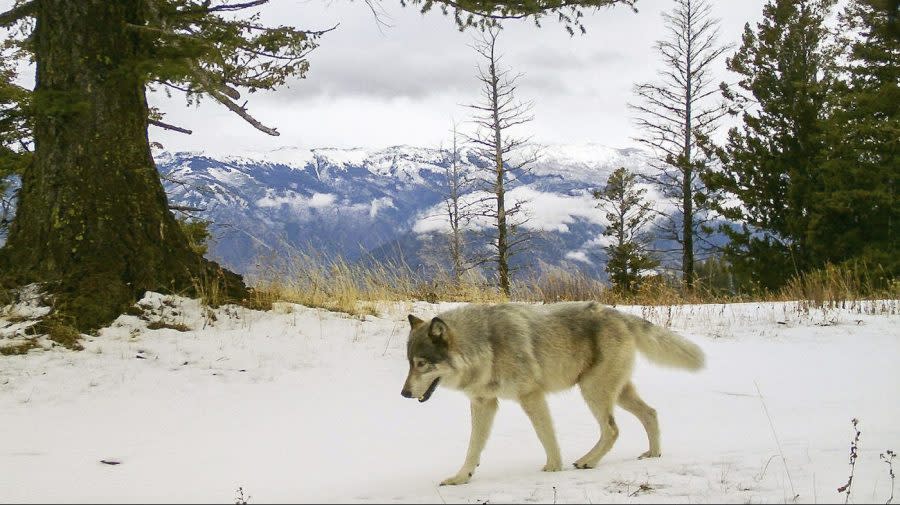Wolf population set to expand in California, Colorado

California’s gray wolf population is expanding amid news of a new wolf introduction plan in Colorado.
Both developments are part of a new phase of expansion for the pack-dwelling apex predators in the American West.
Colorado’s Parks and Wildlife department on Friday released its plans to reintroduce 50 wolves into the state, Colorado Sun reported.
Meanwhile, one of California’s three packs gave birth to eight pups over the spring, the state reported in November, according to The Guardian. The pack’s expansion is a sign of the broader success of Western wolf policy — and a sign of how one state’s reintroduction can drive others.
“The fact that eight pups have made it this far into the year is really exciting,” Amaroq Weiss, a wolf advocate for the Center for Biological Diversity, told The Guardian.
The Whaleback pack, as this extended family is known, also had seven pups last year, The Guardian reported.
Five of these are still with the family, and are likely now participating in hunts or babysitting their younger siblings. This spring’s pups will soon begin attending hunts with the pack as well, wildlife officials told the Guardian.
California’s wolves migrated from Oregon
The story of California’s wolves — which were not deliberately introduced by humans — is a case study in how wolf reintroduction can become a self-sustaining process.
California’s wolf population was exterminated in the 1920s, according to the state Department of Fish and Wildlife.
The first modern wolf in California was a male dubbed OR-7, who migrated from Oregon in 2011, according to the California Wolf Center.
Oregon’s wolves, in turn, seem to have migrated in from the transplanted Canadian packs introduced into Idaho and Yellowstone National Park, according to Oregon Fish and Wildlife.
Prior to this, the last recorded wolf in Oregon was shot in 1947, according to nonprofit Oregon Wild.
Wolf reintroduction remains controversial among rural ranchers, who fear they will kill livestock — which is the reason the carnivores were extirpated in the first place.
There have been about 50 incidents between July and November where Oregon-based wolf packs killed cattle, sheep and goats — leading Oregon officials to “lethally remove” three wolves this fall.
It also led to the illegal shooting of a female wolf in October and the poisoning of an entire pack last winter — both crimes that remain unsolved.
Colorado’s wolf reintroduction
These conflicts are top of mind for Colorado’s reintroduction plan. The state’s last wolves were wiped out in the 1940s as well, and a 2020 state ballot measure to reintroduce wolves passed about 51 percent to 49 percent, according to political tracking site Ballotpedia.
Whether Coloradans supported or opposed wolf reintroduction mapped onto other social fault lines, according to studies from Colorado State University.
Supporters of the 2020 measure tended to be younger, more urban and more likely to support the candidacy of Joe Biden.
By contrast, opponents were more likely to live in precincts near where wolves had been recently seen, to hunt elk (putting them in competition with wolves) and to have supported former President Trump.
“The politicization of wolf restoration reflects a broader trend of politicization of science [which] poses a challenge to conservation efforts to protect our natural world,” said ecologist Mark Fitmer in a statement.
The program’s biggest challenges will be “from social and political issues rather than biological issues,” Eric Odell, head of species conservation for Colorado Parks and Wildlife, said on Friday, according to the Sun.
“An impact based approach recognizes that there are both positive and negative aspects of having wolves and managing wolves,” Odell added.
The program offers $8,000 in compensation to ranchers for any animal killed by wolves — though this is an amount many ranchers worry isn’t enough to cover the loss of, for example, a prize working horse, according to the Sun. (Evidence from Oregon suggests that wolves largely kill calves and lambs.)
It also provides for wolves to be killed if necessary, and for their protections to relax as the population grows.
Once there are more than 150 Colorado wolves for two years running — or 200 at any time, a total of about 25 packs — the state will drop the “threatened” protection.
For the latest news, weather, sports, and streaming video, head to The Hill.

